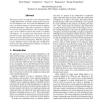Free Online Productivity Tools
i2Speak
i2Symbol
i2OCR
iTex2Img
iWeb2Print
iWeb2Shot
i2Type
iPdf2Split
iPdf2Merge
i2Bopomofo
i2Arabic
i2Style
i2Image
i2PDF
iLatex2Rtf
Sci2ools
FGR
2004
IEEE
2004
IEEE
Face Alignment Under Variable Illumination
This paper presents an approach to face alignment under variable illumination, an obstacle largely ignored in previous 2D alignment work. To account for illumination variation, our method employs two forms of relatively lightinginvariant information. Edge phase congruency is adopted to coarsely localize facial features, since prominent feature edges can be robustly located in the presence of shading and shadows. To accurately deal with features with less pronounced edges, final alignment is then computed from intrinsic gray-level information recovered using a proposed form of local intensity normalization. With this approach, our face alignment system works efficiently and effectively under a wide range of illumination conditions, as evidenced by extensive experimentation.
Related Content
| Added | 20 Aug 2010 |
| Updated | 20 Aug 2010 |
| Type | Conference |
| Year | 2004 |
| Where | FGR |
| Authors | Yuchi Huang, Stephen Lin, Stan Z. Li, Hanqing Lu, Heung-Yeung Shum |
Comments (0)

